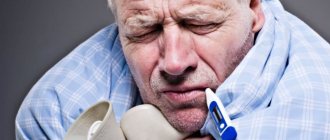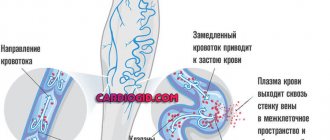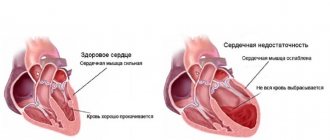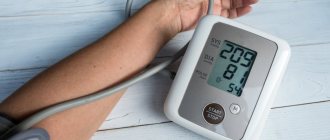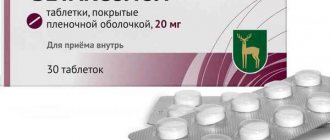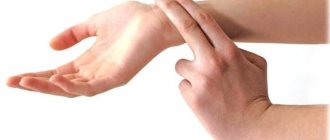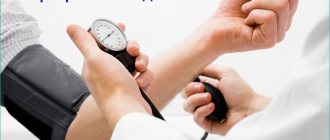How does pulmonary edema manifest?
Main symptoms of the disease:
The disease may manifest as chest pain and shortness of breath.
- hoarse cough;
- shortness of breath, even in the absence of movement;
- chest pain;
- development of tachycardia;
- suffocation (especially when lying down);
- general weakness;
- increased breathing;
- bluish tint of the face and mucous membranes;
- pressure surges;
- discharge of pinkish sputum as a result of coughing;
- problems with consciousness;
- fright;
- presence of hallucinations.
According to the manifestations, pulmonary edema occurs:
- lightning fast - a sharp deterioration in condition, which entails death;
- acute - rapidly increases and requires immediate resuscitation measures;
- subacute - gradual development of symptoms with an undulating course (either subsiding or increasing);
- protracted - the total period of development is up to several days, and can occur without symptoms.
Symptoms
Enter your pressure
130
on
90
Search in progress Not found
Classic symptoms of low blood pressure may include:
- dizziness and lightheadedness - this symptom is quite common;
- rapid breathing;
- thirst;
- unsteadiness of gait;
- shortness of breath when walking;
- decreased or blurred vision;
- weakness in the body;
- tinnitus;
- nausea;
- pale skin;
- cold and clammy sweat;
- loss of consciousness.
Hypotension should be treated if it is symptomatic
Severe hypotension is by no means a safe condition. The brain and cardiovascular system do not have enough oxygen to function properly. In critical cases, the person loses consciousness or goes into shock.
Features of low blood pressure during pregnancy
Doctors call the cause of hypotension in the early stages of pregnancy a natural increase in progesterone, a female sex hormone, one of the effects of which is a decrease in vascular tone. Toxicosis of pregnant women, often accompanied by vomiting and dehydration, plays a role. As a rule, already in the 2nd trimester of pregnancy the condition stabilizes. If the above symptoms continue to be present during the second trimester of pregnancy, they should alert the expectant mother.
Chronically low blood pressure in a pregnant woman is not a harmless condition. It slows down blood circulation, which is dangerous for the development of hypoxia in the fetus and has an extremely negative effect on its development, increasing the risk of miscarriage.
Causes of edema
The symptom manifests itself in pregnant women against the background of gestosis.
Swelling appears under the influence of various factors. But the main ones are high blood pressure and poor vascular function. With arterial hypertension, the arteries narrow and blood moves slowly through them or stagnates. Vessels may have poor patency due to spasm or thickening of the walls, which are secondary signs of some diseases. Edema during pregnancy appears due to a heavy load on the body, displacement of organs, and due to gestosis at different stages.
Most often, edema affects the following organs:
- limbs;
- face and neck;
- lungs.
Swelling of the arms and legs
With hypertension, swollen limbs are immediately noticeable. Most often, when the legs swell, a person feels nagging pain and heaviness in the limbs, and has difficulty moving. If in the first stages this can be dealt with by taking a horizontal position and raising your legs above the heart area, then with the progressive course of the disease, drastic treatment measures are needed.
Swelling of the face
Bags under the eyes are already a good reason to see a doctor.
With increased pressure, swelling of the facial part of the head may occur. It first appears around the eyes in the form of characteristic bags. In the future, the cheeks and nose may swell; the patient feels discomfort that occurs at any time of the day. For some, they disappear without intervention. But this is already a signal to consult a doctor and take measures to eliminate the causes of the disease.
Why do the lungs suffer?
A rapid rise in pressure or crisis can lead to pulmonary edema. The reasons are disruption of the left ventricle of the heart. Wheezing, blurred vision, and chills appear. Fluid begins to accumulate in the lungs and, if the crisis is not stopped in time, this can lead to disastrous consequences. At the first symptoms of suffocation, you need to call an ambulance, lay the patient down, provide an influx of fresh air and give a nitroglycerin or Enapril tablet.
Edema during pregnancy
High blood pressure in pregnant women does not occur suddenly. If hypertension bothered a woman before conception, then during pregnancy its course worsens. The origin of high blood pressure during gestosis is the occurrence of malfunctions in the cardiovascular system, which provoke the appearance of edema. All prescriptions for pregnant women are carried out by a doctor; only he can prescribe effective treatment and help a pregnant woman bear a child. High blood pressure during gestosis creates a danger for the woman and her child.
Edema as a result of low blood pressure
Swelling with low pressure is the result of impaired functionality of internal organs and systems. A common consequence of heart and kidney diseases. To eliminate fluid retention in the body, it is necessary to undergo treatment of the primary disease.
Causes of the disease
This pathology is secondary and appears against the background of other diseases of the body. External factors have little influence on its appearance. Causes of low blood pressure and swelling of the legs:
- hormonal imbalance – diseases of the adrenal glands, pancreas or thyroid gland;
- pregnancy – during this period the volume of blood in the body increases, which is manifested by low blood pressure;
- heart pathologies - heart failure, bradycardia, valve dysfunction;
- blood loss - excessive hemorrhage leads to low blood pressure, sometimes to fainting;
- dehydration is a consequence of excessive physical activity, diarrhea, vomiting, and taking diuretics;
- anaphylactic shock;
- starvation;
- avitaminosis.
Swelling of the legs with low blood pressure in older age appears against the background of heart disease. In women, this condition is more common during endocrine disruptions, including hormonal changes of natural origin - during and after pregnancy, during the formation and completion of lactation, and during menopause.
Mechanism of development of the condition
The work of the heart and kidneys is closely related. At low pressure, the heart pumps blood out with less force.
At this time, the kidneys, by retaining water and salts in the body, restore blood volume to normalize blood pressure.
With hypertension, the opposite happens: the kidneys excrete fluid at an accelerated rate to reduce pressure on the blood vessels. Consequently, the appearance of edema is a consequence of a disruption in the functioning of these organs.
Drinking little water does not help get rid of the pathology. With a lack of fluid, the body tends to make reserves, as a result of which the volume of edema increases. Compliance with the drinking regime normalizes the removal of salts, toxins and water from the body.
Clinical picture
Initially, the patient notices the appearance of edema. The specialist determines the cause of the formation of the latter by their location. With low pressure, swelling of the eyes, face, and lower extremities is more common. The more severe the primary pathology, the more extensive and noticeable the accumulation of fluid becomes. In the first stages of the disease, the symptom may appear only in the evening or morning hours.
Signs of low blood pressure causing swollen legs:
- chronic fatigue;
- weakness;
- dizziness;
- weather sensitivity;
- tachycardia;
- decreased performance, concentration;
- nausea.
The lower the blood pressure, the more pronounced its symptoms. In severe cases, there may be a fainting state, darkness in the eyes, and sometimes loss of consciousness.
Pathology during pregnancy
As pregnancy progresses, the risk of swelling, accompanied by low blood pressure, increases. This is due to a gradual increase in the load on the body as the fetus grows. Signs of pathology during gestation:
- rapid weight gain - a sharp increase in body weight against the background of slow growth of the abdomen - a symptom of swelling;
- the appearance of a rounder face shape;
- the long presence of marks from the seams of tight-fitting clothing is the result of slow blood circulation;
- numbness, tingling in the limbs;
- the tightness of your own shoes is a clear sign of swelling of the feet;
- discomfort from wearing rings, difficulties when removing them from the fingers - a consequence of the spread of swelling to the hands.
Volumetric accumulation of fluid, which worsens the patient’s quality of life, negatively affects the growth and development of the fetus. Extensive swelling with low blood pressure forces a woman to go to the hospital to continue her pregnancy.
Diagnostic methods
To identify the cause of edema with low blood pressure, it is necessary to conduct a comprehensive examination. Prescribed diagnostics:
- General blood and urine tests.
- Biochemical tests of blood and urine.
- Electrocardiogram.
- Echocardiogram.
- Ultrasound of the swollen area.
- Blood test for hormones.
Examinations are necessary to assess the condition of the heart and kidneys and obtain an overall picture of the functionality of the body. In most cases, these studies are sufficient to make a diagnosis.
Emergency help
If the patient’s condition sharply deteriorates with low blood pressure and swelling, it is necessary to massage the cervical region and legs, give a salty product, dark chocolate or a cup of strong, sweet coffee. At the same time, you need to call an ambulance. The patient’s well-being should be monitored before the medical team arrives.
In case of a particularly serious condition, when calling for help, you should check with the dispatcher what needs to be done to maintain the patient’s condition. It is prohibited to administer any medications on your own. In cases where the swelling does not subside and the upper pressure is below 70 units, the person is placed in intensive care.
Therapy
Complex treatment is used to treat edema with low blood pressure. To restore the body, medications and physical exercises are prescribed. It is useful to use traditional medicine recipes and undergo a massage course.
Drugs
Taking diuretics with low blood pressure is strictly prohibited. This method of therapy is relevant only for hypertension. Prescribing such drugs will help reduce the volume of fluid in the body, consequently, a further drop in blood pressure.
For low blood pressure, it is recommended to take medications that have a tonic, vasoconstrictor effect and accelerate metabolism. Caffeine-based products are effective. These drugs improve the activity of the heart and nervous system, resulting in normalization of blood pressure and the disappearance of edema.
Diet
Maintaining proper nutrition is necessary to restore metabolic processes and improve kidney function. The following products should predominate in the diet:
- fruits;
- vegetables;
- lean meat and fish;
- cereals;
- fruit drinks;
- greenery;
- eggs;
- natural juices;
- herbal teas;
- milk and fermented milk products.
Salty, fried, smoked, spicy, fatty, sweet foods should be excluded from the menu - these foods slow down metabolism.
Low-fat meals with little salt help reduce the amount of accumulated fluid. This occurs by accelerating the removal of salts and toxins and facilitating kidney function. With the normalization of the functions of the latter, low pressure gradually increases to normal limits.
Physical exercise
Exercising is necessary to speed up blood circulation and supply more nutrients to muscles and organs. A sedentary lifestyle aggravates the presence of edema.
Low blood pressure is not considered a contraindication to exercise. On the contrary, when it decreases, it is recommended to increase your own activity - this tones the body and normalizes blood pressure. Classes should be canceled in case of severe weakness, dizziness and other similar symptoms - such a condition requires urgent medical attention.
For the treatment of edema and low blood pressure, it is considered optimal to choose one of several sports - swimming, race walking, fitness, yoga, running. It is necessary to perform exercises that affect all muscle groups. Exercises can also be done at home - you need to allocate at least 15-20 minutes to it every day.
Massage
Taking a massage course is useful for restoring blood circulation. A correctly performed procedure speeds up metabolism, improves nutrition of muscle tissue, and has both a tonic and relaxing effect. The swelling becomes significantly less after the first procedure. Simultaneously with its disappearance, low blood pressure rises to normal.
After a massage session with severe swelling, the patient may feel the urge to urinate - this way the accumulated fluid is released from the body.
Folk recipes
With mild edema and slightly low blood pressure, folk remedies can be used as an independent method of treatment. For complete recovery, you need to drink them regularly for 10-30 days. The exact dosage and duration of administration is determined by the doctor.
It is prohibited to use diuretic drugs, so herbs with a tonic effect are selected for treatment. Popular recipes for low blood pressure:
- A collection of yarrow, tansy, prickly steelhead, and immortelle. Increases blood pressure, eliminating swelling.
- Thyme tea. Restores strength, tones, and is used during increased physical and emotional stress.
- Rhodiola rosea. Stimulates the central nervous system, increasing endurance and performance.
- Ginseng root. Normalizes blood pressure, tones, relieves fatigue.
Collections for increasing blood pressure and eliminating edema can be purchased at pharmacies. All medications are taken with caution in case of heart disease.
Preventive actions
You can prevent low blood pressure and edema by monitoring your own health. Experts recommend the following:
- annual medical examination;
- organization of proper rest;
- maintaining proper nutrition;
- regular exercise;
- light foot massage when fatigue and swelling appear;
- drinking at least 1.5-2 liters of water per day;
- selection of shoes with low and medium heels;
- minimal salt intake.
The rules should be followed to the extent possible. They are mandatory for patients with a high risk of falling blood pressure and the appearance of edema.
People who notice frequent occurrence of low blood pressure and swelling need to undergo medical diagnosis. Pathology detected in the initial stages is easiest to treat. Completing comprehensive treatment and following all doctor’s recommendations will ensure a speedy recovery.
Source: https://ObOtekah.ru/vidy/pri-nizkom-davlenii
Edema in chronic glomerulonephritis
The diagnosis of “chronic glomerulonephritis” unites many diseases that differ in the cause and mechanisms of development, the common denominator of which is long-term (from 1 year) inflammation of the renal glomeruli. The edematous form of glomerulonephritis in a chronic course is similar to that in acute glomerulonephritis, but has its own characteristics. First of all, this is a greater severity of symptoms: swelling spreads to the torso, ankles, genitals; in advanced cases, testicular hydrocele, pleurisy, ascites, and pericarditis may occur. The skin becomes waxy and hard. In chronic glomerulonephritis, swelling is difficult to remove and can last for months, sometimes years.
We are taking action
When should you start monitoring high blood pressure and the condition of the lungs, heart muscle, and responding to swelling of the legs? The sooner, the more effective the treatment will be. Not only more effective, but also safer, since the use of a large number of medications also has a detrimental effect on the condition of the body.
Arterial hypertension is symptomatic.
At the same time, hypertension is a chronic disease that is accompanied by disturbances in the functioning of the cardiovascular system and lungs.
Since a lot of palm and coconut fats are added to food, you should be careful when consuming foods that contain them. These are sausages, sour cream, butter, chocolate, cakes, cheeses. Salt is also considered a harmful product that provokes swelling and high blood pressure.
It is what influences how the body reacts to excessive consumption. It is impossible to exclude it from the diet, but anyone can minimize the amount. By excluding salted fish, canned food and pickles, you can significantly facilitate the body’s functioning as usual.
Salt is also considered a harmful product that provokes swelling and high blood pressure. It is what influences how the body reacts to excessive consumption. It is impossible to exclude it from the diet, but anyone can minimize the amount. By excluding salted fish, canned fish and pickles, you can significantly facilitate the body’s functioning as usual.
Canned and semi-finished products contain a large amount of harmful substances, and by refusing to consume them, switching to meals prepared independently in accordance with dietary requirements can help get rid of the problem.
Symptoms
Swelling in hypertension is manifested by the following symptoms:
- dizziness;
- fatigue;
- inadequate sleep;
- blurred vision;
- irritability;
- numbness of the extremities of the body;
- heart pain;
- dyspnea.
If you experience these symptoms, take action immediately. This is a particular problem for people who lead a healthy, active lifestyle and regularly play sports. At the same time, if hypertension and swelling of the legs are not treated in time, there is a risk of other chronic diseases due to which the human body does not function properly.
Do you still think that it is difficult to cure hypertension?
Judging by the fact that you are reading these lines now, victory in the fight against pressure is not yet on your side...
The consequences of high blood pressure are known to everyone: these are irreversible damage to various organs (heart, brain, kidneys, blood vessels, fundus of the eye). In later stages, coordination is impaired, weakness appears in the arms and legs, vision deteriorates, memory and intelligence are significantly reduced, and a stroke can be triggered.
window.RESOURCE_O1B2L3 = 'kalinom.ru'; var m5c7a70ec435f5 = document.createElement('script'); m5c7a70ec435f5.src='https://www.sustavbolit.ru/show/?' + Math.round(Math.random()*100000) + '=' + Math.round(Math.random()*100000) + '&' + Math.round(Math.random()*100000) + '= 13698&' + Math.round(Math.random()*100000) + '=' + document.title +'&' + Math.round(Math.random()*100000); function f5c7a70ec435f5() { if(!self.medtizer) { self.medtizer = 13698; document.body.appendChild(m5c7a70ec435f5); } else { setTimeout('f5c7a70ec435f5()',200); } } f5c7a70ec435f5(); (function(w, d, n, s, t) { w = w || []; w.push(function() { Ya.Context.AdvManager.render({ blockId: 'RA-336323-4', renderTo : 'yandex_rtb_R-A-336323-4', async: true }); }); t = d.getElementsByTagName('script'); s = d.createElement('script'); s.type = 'text/javascript '; s.src = '//an.yandex.ru/system/context.js'; s.async = true; t.parentNode.insertBefore(s, t); })(this, this.document, 'yandexContextAsyncCallbacks '); (function(w, d, n, s, t) { w = w || []; w.push(function() { Ya.Context.AdvManager.render({ blockId: 'RA-336323-3', renderTo : 'yandex_rtb_R-A-336323-3', async: true }); }); t = d.getElementsByTagName('script'); s = d.createElement('script'); s.type = 'text/javascript '; s.src = '//an.yandex.ru/system/context.js'; s.async = true; t.parentNode.insertBefore(s, t); })(this, this.document, 'yandexContextAsyncCallbacks '); (function(w, d, n, s, t) { w = w || []; w.push(function() { Ya.Context.AdvManager.render({ blockId: 'RA-336323-2', renderTo : 'yandex_rtb_R-A-336323-2', async: true }); }); t = d.getElementsByTagName('script'); s = d.createElement('script'); s.type = 'text/javascript '; s.src = '//an.yandex.ru/system/context.js'; s.async = true; t.parentNode.insertBefore(s, t); })(this, this.document, 'yandexContextAsyncCallbacks '); (function(w, d, n, s, t) { w = w || []; w.push(function() { Ya.Context.AdvManager.render({ blockId: 'RA-336323-8', renderTo : 'yandex_rtb_R-A-336323-8', async: true }); }); t = d.getElementsByTagName('script'); s = d.createElement('script'); s.type = 'text/javascript '; s.src = '//an.yandex.ru/system/context.js'; s.async = true; t.parentNode.insertBefore(s, t); })(this, this.document, 'yandexContextAsyncCallbacks '); (function(w, d, n, s, t) { w = w || []; w.push(function() { Ya.Context.AdvManager.render({ blockId: 'RA-336323-1', renderTo : 'yandex_rtb_R-A-336323-1', async: true }); }); t = d.getElementsByTagName('script'); s = d.createElement('script'); s.type = 'text/javascript '; s.src = '//an.yandex.ru/system/context.js'; s.async = true; t.parentNode.insertBefore(s, t); })(this, this.document, 'yandexContextAsyncCallbacks ');
VseDavlenie.ru » All about related problems » Pressure and other diseases
Hypertensive crisis
A sharp increase in blood pressure manifests itself somewhat differently depending on the type of crisis. Unlike small changes in blood pressure, a crisis never goes unnoticed, always giving a certain set of symptoms: a feeling of fear, the appearance of sticky sweat, chills, trembling in the limbs; swelling and redness of the face; blurred vision, spots appearing before the eyes, nausea and even vomiting.
These signs of high blood pressure are characteristic of a person who more often develops a crisis of the eukinetic type. This condition is characterized by a high rate of development. The most common complications: pulmonary edema, manifested by severe shortness of breath up to suffocation, cough with wheezing and pink sputum, and acute heart failure (shortness of breath, paroxysmal cough with discharge of foamy sputum).
A slow increase in symptoms is characteristic of the hypokinetic type of crisis. It is for this reason that the patient is in no hurry to call an ambulance or fight blood pressure. There is a headache, nausea, and dizziness. Usually the patient attributes the deterioration in health to the well-known normal increase in blood pressure and does not bother with unnecessary blood pressure measurements.
A hyperkinetic crisis is associated with a sudden jump in “upper” pressure. Suddenly a severe headache appears, pulsation begins in the temples, “fog” before the eyes, a feeling of heat, vomiting.
It is very important to understand whether a rise in blood pressure in a particular person is a complicated or uncomplicated crisis. This may help prevent serious consequences of high blood pressure, such as heart failure, pulmonary edema, heart attack, and irreversible ischemic changes in the brain.
The uncomplicated course is characterized by rapid development and equally rapid attenuation of the clinical picture. Taking standard antihypertensive drugs can quickly reduce blood pressure to the desired value and improve the patient's condition.
If a person with arterial hypertension is diagnosed with stage II or III, a complicated course of the crisis is most likely. The main signs of high blood pressure in complicated hypertensive crisis:
dizziness; transient severe headaches; manifestations of encephalopathy (vomiting, nausea, vision problems: deterioration of visual acuity, color vision); neurological symptoms (convulsions, paralysis, paresis, problems with sound perception, spatial orientation disturbance); pain in the cardiac region; pain in the area of the scapula, shoulder.
These symptoms can persist for quite a long time even after the attack of high blood pressure has been stopped.
Causes of edema
Edema due to arterial hypertension does not appear immediately. The disease is characterized by a long course and progresses inexorably. In the initial stages, there is a slight increase in blood pressure, which worries the patient periodically, but is quite easily normalized with the help of simple home remedies. Over time, the disease moves into the next stage, which is accompanied by significant blood pressure levels and accompanying symptoms - tachycardia, shortness of breath, facial hyperemia.
Long-term hypertension leads to structural changes in blood vessels. As a result, they lose tone and the walls become less elastic. Poor circulation due to high blood pressure on the walls of blood vessels leads to disruption of the functioning of all organs. The target organs for hypertension are the kidneys, heart and brain. With hypertension, the kidneys and urinary system are primarily affected.
With high blood pressure, kidney function is disrupted, which leads to edema
Complications of hypertension are kidney and heart failure, and pathological changes in the brain due to circulatory disorders.
Swelling of the legs and face with hypertension is observed starting from the second stage and is caused by disruption of the urinary system. This is accompanied by unpleasant symptoms and requires treatment. Otherwise, constant fluid retention in the body leads to increased stress on the heart and kidneys, and disruption of the functioning of these organs.
Swelling due to high blood pressure
High blood pressure worries many people. Especially often, the fact that blood pressure rises and legs swell bothers women during menopause. But men suffer no less from this, and the symptoms of the disease appear very slowly, gradually leading the patient to a gradual deterioration in well-being.
At first it is high fatigue, irritability, dizziness. Many people do not pay attention to these manifestations of the disease, and in the meantime it progresses. The main symptoms are:
poor sleep; general weakness;
The main reasons why blood pressure rises and limbs swell are considered to be hereditary factors, stress and anxiety. But in our time it is impossible to avoid all problems, and an excited, stressful state is almost impossible to avoid.
Therefore, it is important to conduct regular examinations, identify problematic issues in the body’s condition and take appropriate measures.
We should take into account the state of the environment, the place where we live. And how the harmful manifestations of civilization affect our health
Therapy
The wrong choice of therapeutic methods can lead to serious complications, so a doctor should prescribe treatment for swelling in hypertension.
For hypertension, nutritionists recommend avoiding all foods that can lead to fluid stagnation in the body. Among them:
- hot spices;
- coffee;
- black and green tea;
- all foods high in salt;
- sweet carbonated drinks;
- food with preservatives and artificial additives;
- chocolate, cakes, pastries, sweets;
- alcohol;
- sweet juices.
The basis of the diet should be vegetables, fruits, herbs, dairy products, dietary fish, poultry and meat. It is recommended to cook all dishes with a minimum amount of salt and spices.
If you have high blood pressure, you need to drink enough water every day. The norm is calculated from the ratio of 300 ml per 1 kg of weight. In the afternoon, fluid intake should be limited, as excess water before bed can cause edema.
If arterial hypertension is accompanied by swelling, the patient is prescribed diuretics. They help remove excess fluid from the body due to their ability to slow down the absorption of water and salts in the kidney tubules.
Diuretics are divided into 3 categories:
- Potent ones (Bumetamide, Furosemide, Peritanide) - help to simultaneously lower blood pressure and speed up the process of fluid removal. Used as needed in severe cases.
- Intended for long-term use (Indapamide, Hypothiazide, Clopamide) - are part of the main therapy. Relieves swelling and helps prevent new ones from appearing. Accepted by the course.
- Weak (Triamterene, Amiloride, Diacarb) - cope with mild swelling. Additionally, they help lower intracranial and intraocular pressure.
Strong diuretics are contraindicated in cases of hypersensitivity to the components of the drug, dehydration, anuria and insufficient levels of sodium in the blood.
In addition to medications for swelling, medications are prescribed that help normalize blood pressure and eliminate the symptoms of concomitant diseases, if necessary. Such drugs are selected individually.
Traditional methods
Treatment of edema in hypertension can be supplemented with folk remedies. Help speed up the removal of fluid from the body:
- herbal teas from leaves of birch, lingonberry, bearberry, avran officinalis;
- infusion of dill seeds;
- carrot and beet juices;
- sage and flax seed extracts.
Before using traditional recipes, you should consult your doctor to make sure there are no contraindications.
Folk remedies for the treatment of edema and pressure
Traditional, centuries-tested recipes for infusions and decoctions help to quickly get rid of edema and fight high blood pressure with glomerulonephritis. But traditional methods cannot be the only method of treatment. You should not try to cure glomerulonephritis on your own! At the slightest suspicion of kidney disease, you should consult a doctor and strictly adhere to the therapy prescribed by him.
Infusions for swelling and pressure
- Everyone knows the medicinal properties of hawthorn. It has antihypertensive and diuretic effects. To prepare the infusion you need to take 1 tbsp. l. dried hawthorn fruits and pour 300 ml of boiling water. Drink 15 minutes before meals, 1/3 cup.
- Prepare the next infusion as follows: 1 teaspoon of corn silk and the same amount of cherry tails are infused in 500 ml of boiling water. Take half a glass 4 times a day.
- Rose hips have long been considered an excellent diuretic. Take 10-12 rose hips, remove the berries from them, then pour two glasses of boiled water. We drink 100 ml four times a day.
- You need to take 2 tbsp. l. chamomile flowers, plantain leaves, and peppermint, 1 tbsp. l. yarrow, string and St. John's wort. Pour a tablespoon of the mixture into 500 ml of boiling water. Leave for 2 hours. Drink a third of a glass four times a day - before meals and at night.
Decoctions for pressure and swelling
- Take parsley seed 25 g, hops (cones) 10 g, motherwort 30 g. Pour boiling water (300 ml) and boil for half an hour. Strain. Drink 1 tbsp. l. three times a day before meals.
- We take 10 g of dried nettle and strawberry leaves, 20 g of birch catkins and 40 g of flax seed. Mix thoroughly. Boil for 40 minutes in a liter of water. Take 200 ml twice a day before meals.
- 3 tbsp. l. Boil dead bees and 1 liter of water, then reduce the heat and keep for 20 minutes. Drink 1 tablespoon three times a day before meals.
- You need to take 30 g of adonis grass, 50 g of birch and bearberry leaves and 20 g of horsetail. Mix 1 tbsp. l. pour 300 ml of boiled water over the resulting mixture. Bring to a boil and keep on the stove for 10 minutes, then remove from heat and leave for 2 hours. Use 1 tbsp. l. 6 times a day.
Acute glomerulonephritis is a common complication of bacterial tonsillitis, which people are accustomed to enduring on their feet. At the first sign of a sore throat, you should seek help from a doctor so that he can prescribe the necessary treatment. Then the development of acute nephritis can be avoided. Chronic glomerulonephritis can also be cured much faster and more effectively if you seek medical help immediately after the appearance of symptoms such as weakness, fatigue, lower back pain, painful, frequent or, on the contrary, rare urination, swelling and headaches.
Preventive actions
You can prevent low blood pressure and edema by monitoring your own health. Experts recommend the following:
- annual medical examination;
- organization of proper rest;
- maintaining proper nutrition;
- regular exercise;
- light foot massage when fatigue and swelling appear;
- drinking at least 1.5-2 liters of water per day;
- selection of shoes with low and medium heels;
- minimal salt intake.
The rules should be followed to the extent possible. They are mandatory for patients with a high risk of falling blood pressure and the appearance of edema.
People who notice frequent occurrence of low blood pressure and swelling need to undergo medical diagnosis. Pathology detected in the initial stages is easiest to treat. Completing comprehensive treatment and following all doctor’s recommendations will ensure a speedy recovery.
Treatment of eyelid swelling
Treatment of eyelid swelling is aimed at eliminating the primary causes of its appearance or the irritants that cause it:
if the swelling is inflammatory in nature and caused by infection, then antiviral or antibacterial drugs are prescribed. They can be used both topically (in the form of drops, soaks, ointments) and internally. Patients are often prescribed eye washes with special solutions and physiotherapy, which are aimed at quickly eliminating inflammation and swelling. In some cases, the cause of inflammatory edema is a variety of irritating substances. Eliminating the effects of these agents, as well as using a variety of anti-inflammatory solutions for eye rinsing, helps eliminate signs of swelling and inflammation; In case of swelling of the eyelid or soft tissue in the eye area caused by injury, it is necessary to make an effort to treat the injury. If there are no open wounds, but an ice pack or cold compress is placed on the damaged area. Subsequent treatment may include local treatment of the wound with antibacterial or anti-inflammatory drugs, as well as compliance with measures aimed at preventing the damaged area; If the swelling is caused by allergies, then in some cases it may go away on its own. If the swelling is very severe, then in some cases the patient may be prescribed therapy, which consists of taking anti-allergy medications. At the same time, when an allergy is detected, it is extremely important to establish its cause, which caused the swelling of the eyelid. If contact with the allergen is eliminated, this will also speed up the healing process, thereby ensuring the absence of relapses in the future; Treatment of eyelid swelling, which is non-inflammatory in nature, can be prescribed only after the cause of its occurrence has been discovered. If the cause of swelling is a violation of diet or sleep, as well as the introduction of a new diet, then you need to eliminate the problem, apply a cold compress to the eyes, drink diuretics and perform lymphatic drainage massage; a non-inflammatory type of edema, the cause of which is the presence of a fatty hernia, is eliminated surgically. During the excision of excess areas with adipose tissue, it will allow you to refresh your look and completely get rid of swelling. This operation is performed by a plastic surgeon, and minimally invasive and traditional techniques can be used to carry it out.
Medium acting diuretics
Moderately effective diuretics are thiazides. Today, the most commonly used drugs are Chlorthalidone, Dichlorothiazide, Clopamide, Indapamide and Hypothiazide.
Such drugs have a therapeutic effect 30-60 minutes after administration, the maximum effect is achieved after 3-6 hours. So, Clopamide, Hypothiazide and Dichlorothiazide act for 6-15 hours, Chlorthalidone - from 1 to 3 days, Indapamide - 24 hours.
Often, thiazide diuretics are used to treat hypertension when there is no exacerbation. As a rule, the drugs are prescribed in small dosages (up to 25 mg per day), since this amount is quite sufficient to obtain a strong antihypertensive effect.
A stable reduction in blood pressure is often achieved 2-4 weeks after continuous use, with Indapamide having a pronounced effect. Therefore, it is most often used to eliminate swelling due to hypertension.
A contraindication to the use of thiazide diuretics is sensitivity to sulfonamide drugs - Groseptol, Biseptol, etc.
Regarding side effects, diuretics of moderate effectiveness change the water-electrolyte balance, which causes disruptions in various systems and organs.
In addition, the use of such agents reduces the content of magnesium, chlorine, sodium, and potassium ions in the blood and increases the concentration of uric acid and calcium. Negative reactions such as decreased blood pressure, skin rash, malaise, vomiting, nausea, dizziness, etc. are also noted.
Hypertension and edema often occur together. For treatment, diuretics of varying strengths are prescribed. Their task is to remove excess water from the human body. In addition, they help slow down the absorption of salts and fluids in the renal tubules, as a result of which they are excreted along with urine.
Medicines with a diuretic effect increase the rate of formation and volume of urine, reduce the content of water that accumulates in soft tissues and cavities. Diuretic drugs are used as part of complex treatment of hypertension against the background of pathologies of the kidneys, heart, liver and blood vessels.
Depending on their origin, diuretics are:
- Herbal - herbal tea, decoctions based on medicinal herbs, food, etc.
- Synthetic medications in the form of tablets, solution for intravenous and intramuscular administration.
According to their intended purpose, drugs of a synthetic nature can be potent - they are necessary to quickly remove swelling and remove toxins, which leads to a decrease in blood pressure.
Diuretic medications included in the treatment regimen along with other tablets. They are used for a long period of time to treat pathologies of the heart, blood vessels and genitourinary system. As well as drugs to control urination.
List of effective drugs:
- Potent medications. It is advisable to prescribe Furosemide, Torsemide. They are characterized by a quick effect and are taken once.
- Medications of medium action - Clopamide, Indapamide. Drink in courses, prescribed individually for diabetes mellitus and renal failure.
- Potassium-sparing agents – Amiloride. In medical practice they are considered the weakest, but do not remove potassium from the body. Therefore, they are combined with potassium-removing ones to preserve the beneficial substance.
- Osmotic medications are used exclusively for complications and acute conditions.
Swelling due to hypertension
With arterial hypertension, patients often experience swelling in their arms, legs, face, eyelids, and even lungs. Thus, fluid retention in the legs may indicate heart failure.
However, mild peripheral edema occurs due to sodium and water retention, which is associated with impaired renal function and the use of certain medications.
During hypertension, aortic valve defects and symptomatic hypertension, the left ventricle of the heart works in an overstrained mode. This condition is accompanied by an increase in pressure in the pulmonary veins and atrium, which is a prerequisite for the appearance of pulmonary edema.
In case of stress, peripheral vascular resistance increases and LV function becomes more difficult. All this leads to the development of heart failure, leading to blood retention in the lungs. Moreover, against the background of stress and hypercatecholaminemia, blood flow to the lungs increases, which also contributes to swelling.
Diagnostics
Diagnostics includes the following studies:
- blood analysis;
- Analysis of urine;
- echocardiographic examination;
- blood chemistry;
- electrocardiographic study;
- ultrasound examination;
- Diagnosis of hormone levels.
With the help of such tests and procedures, you can find out the exact original source of edema. For example, if during a general blood test the ESR becomes higher than normal, this means that the cause of edema is kidney disease. Or if an ECG reveals ventricular hypertrophy, this indicates that the primary source of arterial hypertension and edema is heart disease.
How to get rid of swelling with diuretics
Diuretics for high blood pressure have different chemical structures, their main purpose is to remove excess fluid from the body. Diuretics slow down the process of reabsorption of salts and water in the kidney tubules, so that they are excreted in the urine.
Moreover, diuretics increase the rate of formation and quantity of urine, reducing the volume of fluid collecting in various cavities and tissues. Diuretics are used as part of complex therapy for hypertension, kidney disease, liver disease and cardiovascular pathologies.
Today there are a lot of diuretic drugs, classified according to different criteria and grouped depending on their origin:
- natural diuretics (herbal teas, herbal decoctions, foods, etc.);
- diuretic medications (solutions for internal administration and tablets).
In addition, according to their intended purpose, drugs that remove fluid are divided into different categories:
- potent - used to quickly eliminate swelling, remove toxins and lower blood pressure levels;
- drugs that are included in complex therapy and used for a long time for diseases of the genitourinary system, kidneys and heart;
- drugs used to control urinary output.
There are also many different classifications of diuretic drugs, which are distinguished by their mechanism of action, chemical structure, side effects, composition and area of application.
Potent drugs include Peritanide, Furosemide, Torsemide, ethacrynic acid and Bumetamide. These medications are prescribed to eliminate swelling and normalize blood pressure in hypertension. They are taken one-time if necessary.
Moderately effective diuretics are Chlorthalidone, Dichlorothiazide, Clopamide, Indapamide and Hypothiazide. They need to be used for a long time together with other medications not only for arterial hypertension, but also to relieve edema syndrome in renal or heart failure, glaucoma or diabetes insipidus.
Potassium-sparing diuretics (Spironolactone, Amiloride, Triamterene) are considered weak drugs, but they do not remove potassium ions from the body. Therefore, they are combined with other diuretics that remove calcium, which allows the ions to be preserved.
Carbonic anhydrase inhibitors (Dichlorphenamide, Diacarb) can also be used to eliminate minor swelling, but they have a weak effect. They are often prescribed to lower intraocular and intracranial pressure.
Osmotic diuretics (potassium acetate, urea, Mannitol, glycerin) are strong drugs used in combination with other medications for acute conditions:
- edema of the lungs, brain;
- lack of urine formation;
- attack of glaucoma;
- peritonitis;
- sepsis;
- shock;
- various intoxications.
How to eat when edema?
To get rid of excess fluid during hypertension, you need to eat a lot of fruits and vegetables (300-500 g per day). First of all, you need to include in your diet:
- apples;
- pepper;
- watermelons;
- parsley;
- cabbage;
- cucumbers;
- zucchini.
Thus, the daily menu of a hypertensive patient should be enriched with a variety of vegetable salads.
Regarding liquids, you need to drink about 2 liters per day. However, for severe swelling, doctors recommend reducing the amount to 1000 - 800 ml.
But if water is retained in the facial area, then with a reduction in the volume of fluid, the swelling will only intensify, since the body itself retains it when there is a shortage of water. Even with hypertension, it is useful to drink properly prepared, high-quality green tea every day.
Strong alcoholic drinks should be avoided, and low-alcohol cocktails can be drunk only occasionally. Coffee is recommended only in the morning and then no more than one cup per day.
In addition, to prevent swelling, you must avoid fast food, foods containing monosodium glutamate, hot spices, marinades, smoked and salty foods.
During the cooking process, it is better not to add salt, but to season it after cooking, because this way much less sodium will enter the body. But it’s better to give up salt altogether and replace it with sauces. For example, a little butter or sunflower oil, onions and sour cream.
Nuts, chili peppers and ginger will help remove excess fluid from the body. It is advisable to replace pork, chicken and beef with lean fish.
The most useful fermented milk products for swelling are:
- curdled milk;
- cottage cheese;
- kefir.
First aid algorithm for low blood pressure
Most people are at a loss when faced with low blood pressure, having no idea what to do to normalize the condition. Experts recommend adhering to the following algorithm:
Lie down: Whenever you experience dizziness, lightheadedness, or any other symptom of low blood pressure, lie down on a flat surface with a small pillow under your feet. Close your eyes and wait until you feel better. Always keep oral rehydration salt with you and use it if necessary: this is a special powder for solution (for example, Regidron), which can be purchased at the pharmacy. This remedy helps restore fluid reserves and electrolyte balance after dehydration due to vomiting and diarrhea. Drink water: If you don't have a rehydrating product on hand, drink plain water. You can also prepare the solution yourself from clean water, a pinch of salt and sugar. Sodium raises blood pressure, and sugar helps restore glucose levels (low blood glucose, or hypoglycemia, can be caused by dehydration). Use table salt: Yes, a way that works well for most people to stabilize their blood pressure is to lick the salt a few times or eat salty foods. But you should not eat or drink excessive amounts of salt, as this can, on the contrary, lead to increased blood pressure. Seek medical help once the condition returns to normal. Most people do not consider it necessary to be examined for low blood pressure
But identifying the root cause is really important. In some cases, a person may not feel the moment preceding the crisis when the pressure drops below 110/60 mmHg
Art. In this case, independent measures will not be enough.
It is important to remember that in case of any circulatory disorder, including hypotension, the cause of the pathology should be determined by a doctor, in which case it is necessary to consult a cardiologist
LiveInternetLiveInternet
—Categories
- vitamins for eyelash growth (0)
- careprost eyelash growth product (0)
- home remedy for eyelash growth (0)
- Faberlic for eyelash growth (0)
- Alerana for eyelash growth (0)
- feg for eyelash growth (0)
- best product for eyelash growth (0)
- serum for eyelash growth eyelash booster reviews (0)
- serum for eyelash growth and strengthening (0)
- serum for eyelash growth eyelash reviews (0)
- oil for eyelash growth reviews (0)
- what oil for eyelash growth (0)
- for eyelash growth and thickness (0)
- mask for eyelash growth (0)
- eyelash booster reviews (0)
- castor oil for eyelash growth (0)
- for eyelash growth eyelash reviews (0)
- for eyelash growth castor (0)
- buy eyelash growth product (0)
- eyelash growth activator (0)
- gel for eyelash growth (0)
- eyelash growth stimulator (0)
- lash for eyelash growth (0)
- careprost for eyelash growth (0)
- for eyelash growth price (0)
- eyelash growth booster serum (0)
- eyelash growth serum (0)
- eyelash growth product in pharmacies (0)
- eyelash growth serum reviews (0)
- strengthening and growth of eyelashes (0)
- eyelash booster for eyelash growth (0)
- booster for eyelash growth (0)
- for eyelash growth at home (0)
- eyelashes eyelash growth (0)
- for eyelash growth buy (0)
- eyelash growth product reviews (0)
- for eyelash growth in pharmacies (0)
- eyelash growth serum (0)
- oil for eyelash growth (0)
- for eyelash growth reviews (0)
- eyelash growth product (0)
- for eyelash growth (0)
- eyebrow growth product buy (0)
- best product for eyebrow growth (0)
- eyebrow growth oil in the pharmacy (0)
- eyebrow growth products in the pharmacy (0)
- eyelash and eyebrow growth at home (0)
- alerana eyelash and eyebrow growth stimulator (0)
- eyebrow growth gel (0)
- eyebrow growth activator (0)
- burdock oil for eyebrow growth (0)
- for eyelash and eyebrow growth in the pharmacy (0)
- eyelash and eyebrow growth stimulator reviews (0)
- what oil for eyebrow growth (0)
- for better eyebrow growth (0)
- eyebrow growth stimulator reviews (0)
- eyebrows hair growth (0)
- castor oil for eyebrow growth (0)
- for eyebrow growth buy (0)
- masks for eyebrow growth (0)
- oil for eyebrow growth reviews (0)
- pharmacy for eyebrow growth (0)
- serum for eyebrow growth (0)
- for eyebrow growth at home (0)
- for eyelash and eyebrow growth reviews (0)
- eyelash and eyebrow growth stimulator (0)
- eyebrow growth product reviews (0)
- eyebrow growth stimulator (0)
- eyelash and eyebrow growth product (0)
- oil for eyebrow and eyelash growth (0)
- for eyebrow growth reviews (0)
- eyebrow growth product (0)
- eyebrow growth oil (0)
- for eyelash and eyebrow growth (0)
- for eyebrow growth (0)
We advise you to read: How to relieve swelling from a bee sting
—Search by diary
—Subscription by e-mail
-Statistics
Methods of treating the disease
To treat the disease, a complex of medications is used.
The main place in the fight against pulmonary edema is occupied by therapy using medications. To treat the disease, the doctor prescribes medications to eliminate foam in the lungs, nitrates - in case of symptoms of cardiac ischemia and high blood pressure. In order to remove excess fluid from the body, it is necessary to drink a course of diuretics. Depending on the pressure readings, the rest of the complex of drugs is regulated: cardiac glycosides, antihypertensive, antiarrhythmic, thrombolytic, hormonal, antihistamine drugs. Do not forget about preventive measures, especially leading a healthy lifestyle, getting rid of bad habits, and following the doctor’s recommendations.
Effective treatment
It is better to entrust the treatment of swelling due to pressure to a good specialist, who, based on the diagnostic results, will prescribe the most effective treatment.
In order to eliminate swelling, it is necessary, first of all, to monitor nutrition and follow a suitable diet for hypertension. Table number 10 works well. It is necessary to minimize the consumption of salt and spicy foods.
Food should not be high in calories. You don't need to drink a lot of water! It is also important to take diuretics (diuretics) to improve the removal of excess fluid from the body.
It is imperative to normalize blood pressure with the help of medication and folk remedies.
Medicines should be prescribed by the attending physician, based on the course of the disease and the individual characteristics of the body. You cannot self-medicate.
If the swelling is not too pronounced, it is often recommended to drink rosehip infusion, take Furosemide, Taurine, Hypothiazide, Torasemide, Warfarin.
Treatment of edema can be surgical or conservative.
Recommendations for patients
To eliminate this symptom at home at the initial stage of the disease, it is enough to follow some recommendations:
- Several times a day, while in a supine position, you need to raise your lower limbs using a bolster or a pillow (you need to place it under your knees).
- Try not to put too much strain on your legs and wear compression stockings.
- Monitor the amount of liquid you drink. It should be no more than a liter per day.
- Salt intake should also be kept to a minimum.
- You can't steam your feet or take hot baths.
- It is advisable to do a light massage of the legs and feet a couple of times a day.
- If you are overweight, you need to get rid of it.
Folk remedies
Traditional methods of treatment help well if the disease is not yet in an advanced form.
In this case, you can resort to the following methods:
- Make herbal contrast baths. To do this you need to prepare two basins. One with cold, the other with moderately hot water. It is recommended to add various herbal infusions (sage, chamomile, pine, mint) and essential oils as desired (tea tree, sage, bergamot, fir, spruce).
- Before going to bed, you can apply cold or vinegar compresses to your feet. The vinegar compress is made as follows. You need to take 300 ml of water at room temperature and add three tablespoons of vinegar there. Soak gauze or a small towel in this water. If you carry out this procedure regularly, the swelling will soon cease to bother you.
- For swelling, infusions and decoctions should be used internally. Infusions of parsley, birch buds, and chestnut help well. Crushed dry herbs and fruits should be poured with boiling water (a tablespoon of herbs per glass of boiling water) and left for about an hour. The glass should be divided into three doses per day and drunk after meals.
Drug therapy
If we talk about drug treatment of edema, diuretics are usually prescribed to help remove excess fluid. These can be thiazide drugs (Indapamide, Dichlorothiazide, Navidrex) or loop drugs (Diuver, Lasix). Only a cardiologist should prescribe the appropriate medicine and take it in accordance with his recommendations.

